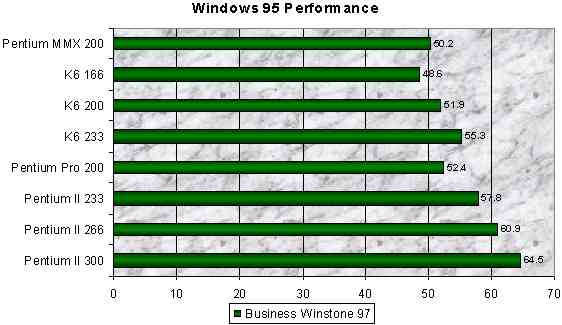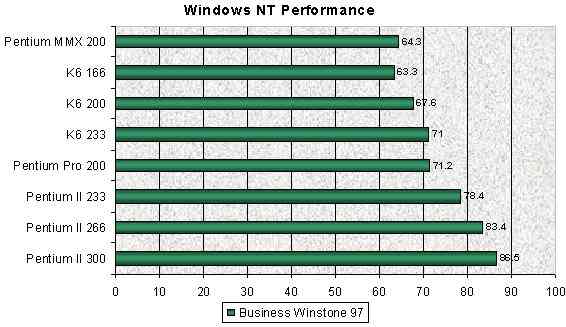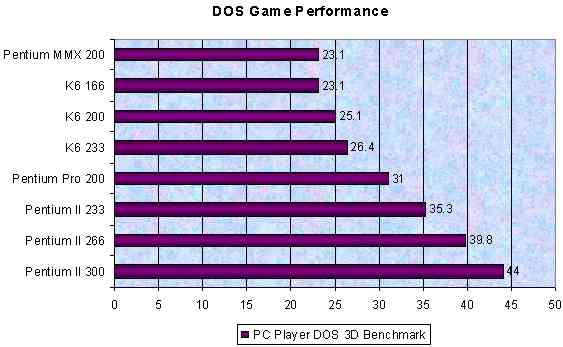The Empire Strikes Back: Intel's Pentium II CPU
Introduction
Exactly four weeks ago AMD unveiled their new K6 CPU. On the launch day AMD was even proudly presenting a K6 at 266 MHz and the whole word was applauding to this new powerful competitor of the 'almost-monopolist' Intel. The performance of the K6 is very promising and for the first time the PC users in the world were directing their interest away from Intel to AMD. Now since the first four weeks are over, we had to learn that there still isn't any K6 at 266 MHz available at all. Even in the US people are struggling to get a K6 233 and in Europe and the rest of the world you hardly get any K6 CPUs at all.
Now since my review of the first Klamath CPU from the beginning of this year and all the fuss that happened after its release, Intel hasn't been lazy. They knew that they had to come out with something really decent, because the first impressions of the Klamath/Pentium II CPU weren't exactly impressive, they got a lot of bad press and the K6's performance was good enough to get a lot of attention as well. The core of the Pentium II is still not very much different from its predecessor Pentium Pro, but it doesn't include any level two cache anymore and so a considerable performance boost over the Pentium Pro is only achievable through higher clock rates. Since my first Klamath review Intel has certainly improved the chip itself, but also increased the clock rates up to now 300 MHz.
Just in case you haven't read my first Klamath review yet, here again the facts about the Pentium II:
Facts About The Intel Pentium II
- The Pentium II doesn't include any second level cache anymore as its predecessor Pentium Pro. This is due to production costs, since in case only one die in the Pentium Pro is not functioning in the post-bonding CPU tests, the whole CPU has to be thrown away. The chips can only be tested after the bonding and at this stage it's too late to use one of the two components anymore.
External L2 cache means less L2 cache performance. The Pentium Pro runs its internal L2 cache at clock speed, the Pentium II will run its external special BSRAM (burst static RAM) cache only at half the clock speed, which makes this cache considerably slower than in the Pentium Pro. - The external bus speed of the Pentium II will still be only 66 MHz, the bus speed we know well from Pentium and Pentium Pro CPUs. Obviously Intel doesn't seem to plan higher bus speeds before the release of the next CPU, the Deschutes.
- The Pentium II will come as a cartridge for the new so called 'Slot One' motherboard slot. We all expected it anyway - we will need new motherboards for the Pentium II. On this slot card there will be the L2 cache as well, which is planned to be 512 and later also 256 kB in size. The old Pentium Pro can also be used on these new boards, via a special CPU card with a Socket 8. This CPU card can be build by motherboard manufacturers, but they'll have to pay a considerable price for each card, since the 'Slot One' is patented by Intel.
- The CPU speed of the first Pentium II will be 233, 266 and 300 MHz . This makes a multiplier of 3.5 x 66 MHz for the 233 version, with a multiplier of x1.75 for the L2 cache, a 4 x 66 MHz for the 266 MHz version, with a L2 cache multiplier of x2 and so on. On some exhibitions Intel has shown a Pentium II 400 MHz (water cooled), but it's unclear at which speed the level 2 cache was running then.
- The Pentium II ('Klamath') will now have segment register caches, which will improve the poor 16 bit performance known from the Pentium Pro. Hence the Pentium II will run 16 bit programs and mixed 16/32 bit OSs like Windows95 somewhat faster than the Pentium Pro.
- The first level cache of the Pentium II will be increased to 16 kB data and 16 kB instruction cache. The Pentium II will have more write buffers as well. These two things increase the L1 cache performance of the Pentium II and help reduce the Pentium II's disadvantage of its slower external L2 cache.
- Due to less production costs, the Pentium II ('Klamath') could be even cheaper than the Pentium Pro. However, we'll have to wait for its release to be sure about this. I personally doubt this! Some sources say that the production costs of the Pentium II are only 25% of the costs to produce a Pentium Pro.
- We might get the same trouble with the Pentium II availability as we currently have with the K6. Sources say that Intel currently doesn't have any interest in cutting down the (considerably high) prices of the Pentium II (rumors say that the Pentium II 300 will cost $2000 !!), because they are completely unable to satisfy the market with enough Pentium II CPUs.
The Performance Of The Intel Pentium II
The Pentium II has now to compete against two CPUs. It's older brother the Pentium Pro, which has the advantage of an internal 2nd level cache and the new AMD K6, which has been showing to be a worthy competitor against even the high end Intel CPUs.
The Windows 95 Performance Of The Pentium II
| WINDOWS 95 | Pentium II 300 | Pentium II 266 | Pentium II 233 | Pentium Pro 200 | K6 233 | K6 200 | K6 166 | Pentium MMX 200 |
| Business Winstone 97 | 64.5 | 60.9 | 57.8 | 52.4 | 55.3 | 51.9 | 48.6 | 50.2 |
| Highend Winstone 97 | 31.7 | 29.8 | 27.8 | 24.8 | 23.6 | 22.2 | 20.1 | 22.4 |
| Business Winmark 97 | 124 | 107 | 103 | 84.2 | 98.1 | 89.7 | 78.5 | 91.4 |
| WinQuake 1.09 Timedemo2 640x480 | 32.7 | 30.0 | 27.0 | 23.4 | 15.5 | 13.9 | 12.6 | 15.9 |
The Windows 95 performance is the only sector where the lead of the Pentium II isn't that all clear. The Pentium II 233 is only a little bit faster than the AMD K6 233, but the faster clock speeds are still far above any competition. However here in this sector the Pentium II could be defeated by a improved K6 as well as the upcoming M2. It will stay interesting for Windows 95 users.
The Windows NT Performance Of The Pentium II
Windows NT is like all the other 32 bit operating systems the way to go for the future. Memphis includes already quite a bit more NT code than Windows 95 and sooner or later 32 bit software and operating systems will be the standard. Hence the performance under a 32 bit OS like Windows NT is most important.
| WINDOWS NT 4.0 | Pentium II 300 | Pentium II 266 | Pentium II 233 | Pentium Pro 200 | K6 233 | K6 200 | K6 166 | Pentium MMX 200 |
| Business Winstone 97 | 86.5 | 83.4 | 78.4 | 71.2 | 71 | 67.6 | 63.3 | 64.3 |
| Highend Winstone 97 | 37.7 | 35.3 | 32.2 | 29.2 | 26.9 | 24.5 | 22 | 24.2 |
| Business Winmark 97 | 139 | 128 | 117 | 104 | 104 | 93.5 | 83.6 | 87.5 |
| Winbench 97 CPU Mark16 | 600 | 533 | 466 | 360 | 465 | 414 | 362 | 423 |
| Winbench 97 CPU Mark32 | 815 | 722 | 632 | 554 | 559 | 513 | 466 | 420 |
You can see that 32 bit OS environments are exactly what the Pentium II loves, just as well as his predecessor and close brother Pentium Pro. The distance to the K6 is vast and so you won't have to have many doubts that the Pentium II is the CPU for hard working 32 bit servers or workstations, unless you want to have a look at Digital's Alpha CPU. You can see that Intel has particularly improved the Pentium II's 32 bit performance over the fairly poor results of the first look Klamath from the beginning of this year. Under Windows NT, the Pentium II will give AMD quite a bit of a headache, because the K6 will still have a good way to go if it wants to compete to the Pentium II under this kind of OS. Even if you overclock a K6 to 250 MHz, you can't even reach the NT performance of the Pentium II 233.
Get Tom's Hardware's best news and in-depth reviews, straight to your inbox.
The High End Winstone shows that the Pentium II is also the way to go in case you need lots of CAD or rendering power. This is so far one of the weaknesses of the K6, as well as its lack of multi CPU support. It's a matter of fact that the real high end user will have to go for a Pentium II system. Intel's plans have worked out another time.
The DOS Performance Of The Pentium II
| DOS | Pentium II 300 | Pentium II 266 | Pentium II 233 | Pentium Pro 200 | K6 233 | K6 200 | K6 166 | Pentium MMX 200 |
| Quake 1.06 Timedemo2 640x480 | 29.9 | 27.6 | 25.0 | 21.9 | 14.2 | 13.4 | 12.2 | 15.7 |
| PC Player DOS 3D Benchmark | 44 | 39.8 | 35.3 | 31 | 26.4 | 25.1 | 23.1 | 23.1 |
| 3DBench | 500 | 500 | 500 | 333.3 | 250 | 250 | 200 | 166.6 |
| Chris Dial's 3D Bench | 82.5 | 75.2 | 67.5 | 49.6 | 38.4 | 35.3 | 31.7 | 40.7 |
The DOS Gaming Performance of the Pentium II is simply earth shattering. I'm sure that nobody is still thinking I'm any kind of close to Intel, but I have to say what's the truth here. Looking at the Quake results makes you almost feel sorry for AMD, since the results of the Pentium II are more than double in Quake as well as in Chris Dial's 3D Bench - both heavily FPU depending benchmarks. Even the almost 'FPU-free' and hence most realistic benchmark of the PC Player Magazine shows that for real game junkies there's no other CPU than the Pentium II.
The mmX Performance Of The Pentium II
| Intel Media Benchmark | Pentium II 300 | Pentium II 266 | Pentium II 233 | Pentium Pro 200 | K6 233 | K6 200 | K6 166 | Pentium MMX 200 |
| Overall | 392.28 | 357.99 | 312.83 | 194 | 246.52 | 214.46 | 181.58 | 246.57 |
| Video | 341.84 | 315.33 | 276.61 | 160.22 | 308.54 | 269.14 | 228.71 | 252.07 |
| Image Processing | 1250.27 | 1148.14 | 1051.64 | 219.7 | 697.16 | 605.07 | 527.55 | 684.98 |
| 3D | 312.14 | 283.34 | 247.49 | 211.55 | 141.07 | 122.15 | 102.77 | 159.78 |
| Audio | 510.09 | 459.95 | 395.88 | 232.32 | 273.22 | 238.11 | 200.79 | 326.58 |
As you can see, the Pentium II has the lead here as well. The only exception where AMD's K6 is looking pretty good is the video sector. Here the K6 233 comes pretty close to the Pentium II 266. This is interesting for people who are e.g. looking into DVD videos or any other video usage of the PC. The image processing is a big strength of the Pentium II and the 3D graphics, which mainly depend on the FPU performance rather than MMX (as you can see at the MMX-less Pentium Pro result) are also very strong in the Pentium II.



